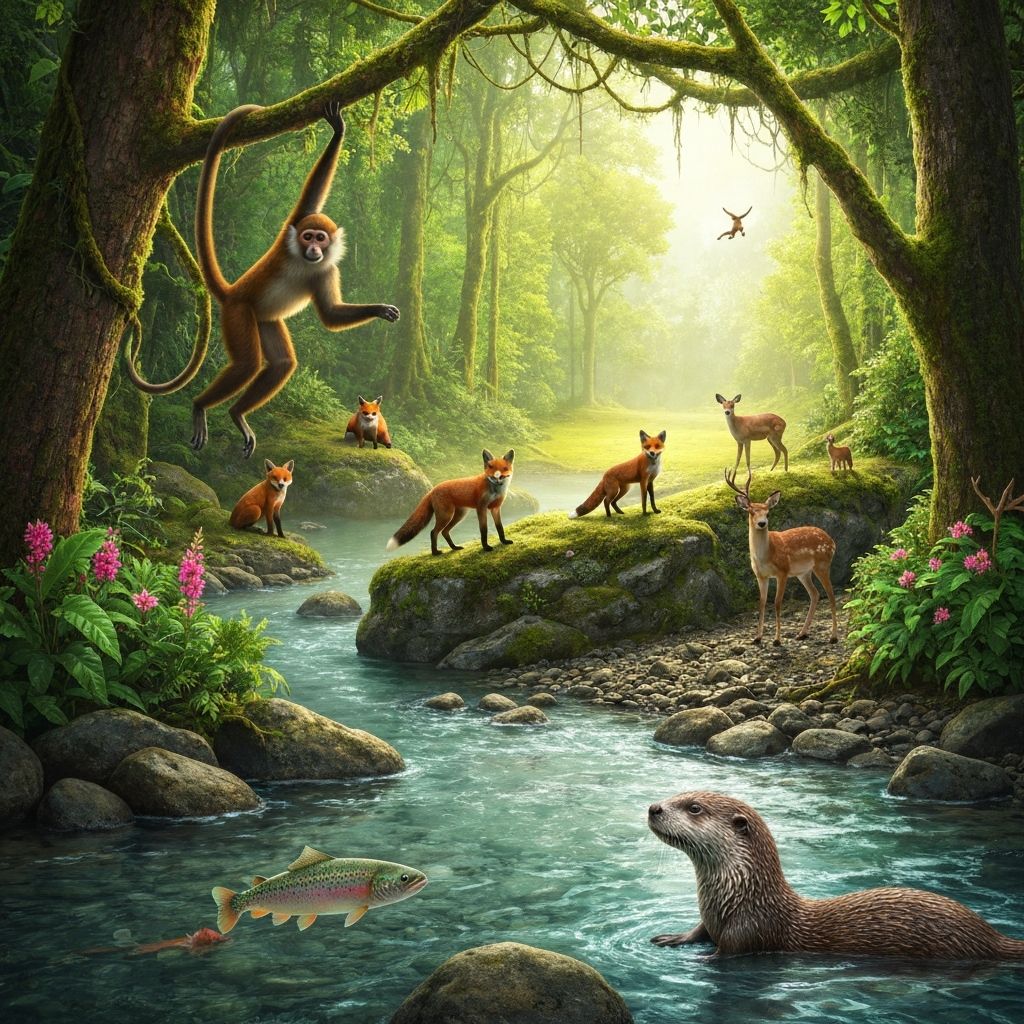Ecosystem Balance
Discover how animals maintain the delicate balance that keeps our planet healthy and thriving

What is Ecosystem Balance?
Ecosystem balance is like a giant, invisible web that connects all living things on Earth. Every animal, plant, and microorganism plays a specific role in keeping this web strong and stable. When animals fulfill their roles - whether as predators, prey, pollinators, or decomposers - they help maintain the health of entire ecosystems.
Think of an ecosystem like a perfectly balanced seesaw. If one side gets too heavy or too light, the whole thing tips over! Animals help keep this "seesaw" balanced by controlling populations, spreading seeds, cleaning up waste, and much more.
🌟 Amazing Fact!
A single bat can eat up to 1,000 mosquitoes in one hour! Without bats, we'd be overwhelmed by insects, and many crops would fail without their natural pest control.
How Animals Maintain Balance
Pollinators
Bees, butterflies, and hummingbirds transfer pollen between flowers, helping plants reproduce. Without pollinators, we wouldn't have most of our fruits, vegetables, and flowers!
Predators
Lions, wolves, and hawks keep prey populations in check. This prevents overgrazing and maintains healthy plant communities, which benefits the entire ecosystem.
Ecosystem Engineers
Elephants, beavers, and prairie dogs physically change their environment. They create habitats for other species, dig water holes, and spread seeds across vast distances.
Seed Dispersers
Birds, bats, and monkeys eat fruits and spread seeds far and wide. This helps forests regenerate and plants colonize new areas, maintaining biodiversity.
Decomposers
Worms, beetles, and vultures break down dead matter and return nutrients to the soil. They're nature's recyclers, keeping ecosystems clean and fertile!
Water Purifiers
Fish, mussels, and wetland animals filter water and remove pollutants. They keep our rivers, lakes, and oceans clean and healthy for all life.
Conservation and Food Systems
Maintaining ecosystem balance is crucial for food security. Healthy ecosystems provide pollination for crops, natural pest control, and fertile soil. When we protect wildlife, we're also protecting our ability to grow food sustainably.
Conservation efforts focus on preserving biodiversity, protecting habitats, and promoting sustainable practices. By understanding how animals maintain balance, we can work with nature instead of against it.
Sustainable Farming
Farmers who work with nature use beneficial insects for pest control, maintain hedgerows for pollinators, and rotate crops to keep soil healthy.
Ocean Conservation
Protecting marine ecosystems ensures healthy fish populations, clean water, and coastal protection from storms and erosion.
The Yellowstone Wolf Story
In 1995, wolves were reintroduced to Yellowstone National Park after being absent for 70 years. What happened next amazed scientists! The wolves hunted elk, which had been overgrazing the vegetation. With fewer elk, trees and shrubs grew back.
The returning vegetation stabilized riverbanks, changed the course of rivers, and created habitats for beavers, birds, and fish. This is called a 'trophic cascade' - when one species affects the entire ecosystem. It shows how important every animal is!
How YOU Can Help Maintain Balance
Plant Native Flowers
Create a pollinator garden with native flowers that bloom at different times of the year.
Build Wildlife Homes
Put up bird houses, bat boxes, and insect hotels to provide safe habitats.
Avoid Pesticides
Use natural pest control methods instead of chemicals that harm beneficial insects.
Reduce Waste
Recycle, compost, and reduce plastic use to keep ecosystems clean.
Learn and Share
Study local ecosystems and teach others about the importance of balance.
Support Conservation
Join or donate to organizations working to protect wildlife and habitats.